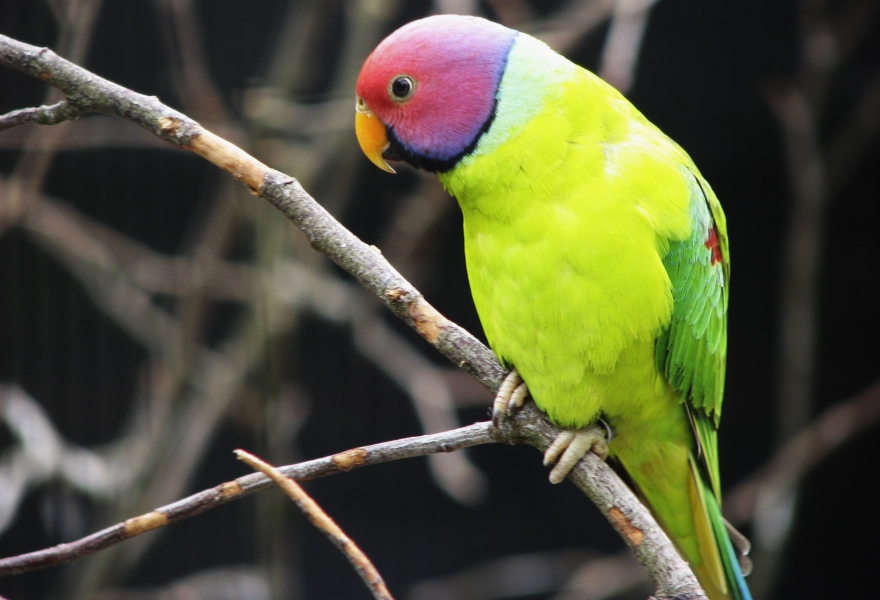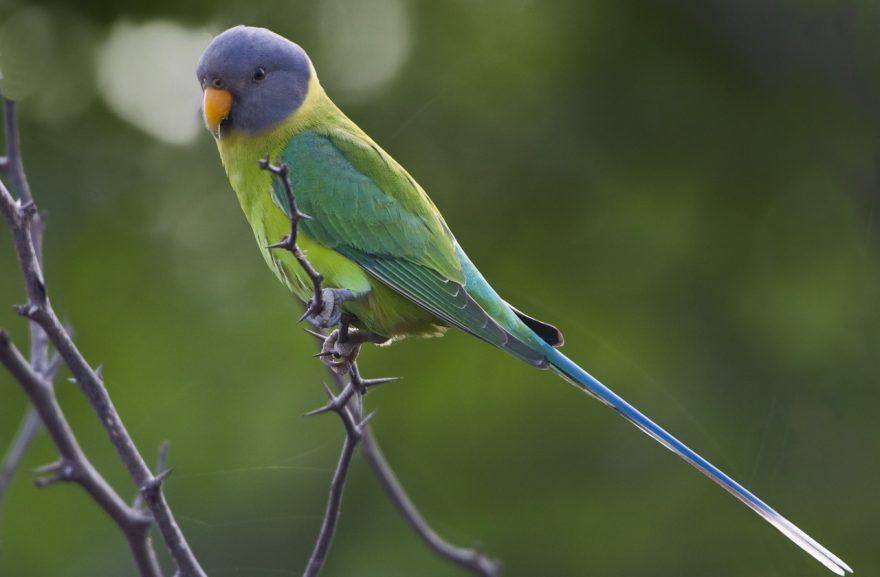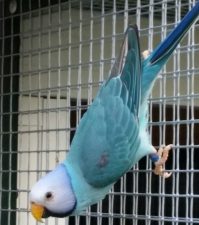The Plum-headed parakeet is an Asiatic parrot species native to the Indian subcontinent. They are infrequently seen in captivity outside of India, but are considered to be reasonably established and secure in aviculture. The species is suitable as both a companion bird or an aviary bird. Only male Plum-headed parakeets possess the vividly colorful head, which is acquired at around 18 months of age. The female has a blueish grey head and darker, less vibrant green plumage.

Housing & Compatibility
Plum-headed parakeets are placid birds that can share an aviary with other placid parrots (such as Neophemas), finches and doves. The female may become aggressive during the breeding season (which occurs in the spring), at which point single-pair aviaries may be necessary.
Plum-headed parakeets should be provided with an adequate amount of flying space to ensure they receive sufficient exercise. Birds that do not have room to fly may suffer from stress or obesity. Three meters of uninterrupted flying space is recommended.
Plum-headed parakeets tend to be resilient to cold temperatures due to the high altitude of their native habitat, but it’s still important to provide protection from cold cold draughts. Provide protection from hot weather if necessitated by your local climate.
Branches from non-toxic trees should be provided as natural perches. The birds will also enjoy chewing on bark, leaves and seeds for entertainment and beak exercise.
Plum-headed parakeets are closely related to Blossom-headed parakeets and Slaty-headed parakeets and may interbreed. To avoid producing hybrid birds that damage the limited captive gene pool of each distinct species, these birds should not be housed together. Hybrids between male Rose-ringed parakeets (Indian Ringneck) and female Plum-headed parakeets have also been reported.
Diet & Feeding
Seed forms the basis of the Plum-headed parakeet’s diet. A quality mix designed for small parrots or Lovebirds will be acceptable. Plum-headed Parakeets also require a wide variety of fruit and vegetables to ensure good health. They prefer sweet juicy fruits such as apple and pear; however, it’s important that more nutritious green food are included in their diet. Broccoli, kale and bok choi are especially nutritious – as are corn, cucumber, peppers and berries.
Pellets can be used a more nutritious alternative to seed, but many birds are unwilling to consume them.
Plum-headed parakeets like to hold their food in one foot while perching with the other. Cutting fruits and vegetables into cubes of roughly one square inch will allow them to practice this natural behavior.

Breeding
Plum-headed parakeets have a reputation for being difficult to breed. Even under ideal conditions, they will only produce one clutch of 3-6 eggs per year.
Breeding usually commences in spring as the weather begins to warm up. The male will court and feed the hen, who will begin inspecting available nesting boxes. Several different nesting boxes should be provided, as they are known to reject some nesting boxes for seemingly arbitrary reasons.
Incubation is performed exclusively by the hen and lasts for roughly three weeks. Young birds will fledge at 6-7 weeks of age and become fully independent from their parents a month later. Young birds can usually be housed with their parents, but they must be separated immediately if aggressive behavior is observed.
Nest box
Plum-headed parakeets will accept a wide range of different nesting boxes or logs. A commercial nesting box designed for medium-sized parrots – either rectangular or Z-shaped – is ideal. An inch-thick layer of shaved pine or sawdust should be placed in the bottom of the nest.
Sexing
Only the male bird possess the namesake “plum head,” making adult birds very easy to visually sex. Juvenile birds of different sexes remain identical for twelve months or more until the males begin to develop different-coloured head feathers. DNA sexing is the only way to accurately determine gender before this point.

Color Mutations
Mutations are extremely rare and few have been established. Cinnamon, opaline, yellow, and several forms of blue have been observed.
As Pets
Plum-headed parakeets are not frequently kept as companion birds, however it is understood that they make excellent pets. They are competent talkers and have a reputation for being friendly and confiding. Like most Asiatic parrots, Plum-headed parakeets often go through a period of “bluffing” during the early years of their life. Bluffing is somewhat like human puberty in that it causes erratic, sometimes aggressive behaviour due to hormonal changes. With patience and commitment, this developmental stage will inevitably pass.
Health
Plum-headed parakeets are a hardy and resilient species, but the following preventative health measures should still be taken.
- A strict worming and parasite control regime.
- Maintain excellent hygiene by routinely cleaning the aviary of discarded food and bird droppings.
- Clean water dishes daily.
- Remove fresh foods before they begin to rot or ferment.
Well looked-after Plum-headed parakeets will live for 20-30 years.
My female at three years has suddenly changed the colour on her head to red/purple. She was very sick a few months ago with a liver infection but the vets cured it with antibiotics. She very healthy now but seems to be buffing not as friendly as she was?? Not if male or female now?
Thats not a female then. If the head has turned red thats a boy. Female plumheads have a grey head which in certain loght looks lilac (light purple at best)
Thats what i suggest as someone who works for a breeder of plum heads and other parakeets.
Did the breeder you bought them from prove they were a girl to you re dna? If not i think they lied or were just mistaken. It happens when they dont get dna done on young burds as before the colour comes in you cant really tell otherwise.
Do female plum heads get vocal during breeding
I live in Victoria and I feed the wild Lorikeets and Galah’s daily with seed for wild birds. The last few weeks a female Plumhead has been amongst them. I strongly believe that she was someone’s pet. I worry that she is not getting enough food as the Lorikeets and Galahs can be quite bossy and keep her away from the seed.
Do you have any suggestions please and also will it be too cold in winter for this bird to survive?
Thank you
Plum heads come from the foothills of the Himalayas and can tolerate a few cold nights. If this bird has joined a flock, she’s probably going to be fine.
Still, you should try to catch her to prevent a feral population from establishing one day. As pretty as that would be.
Hi Shane,
Thank you for your reply. How do I catch her? As soon as I walk outside, she along with the many Lorikeets and Galahs immediately fly up into the trees.
Any suggestions would be helpful. Thank you 😊